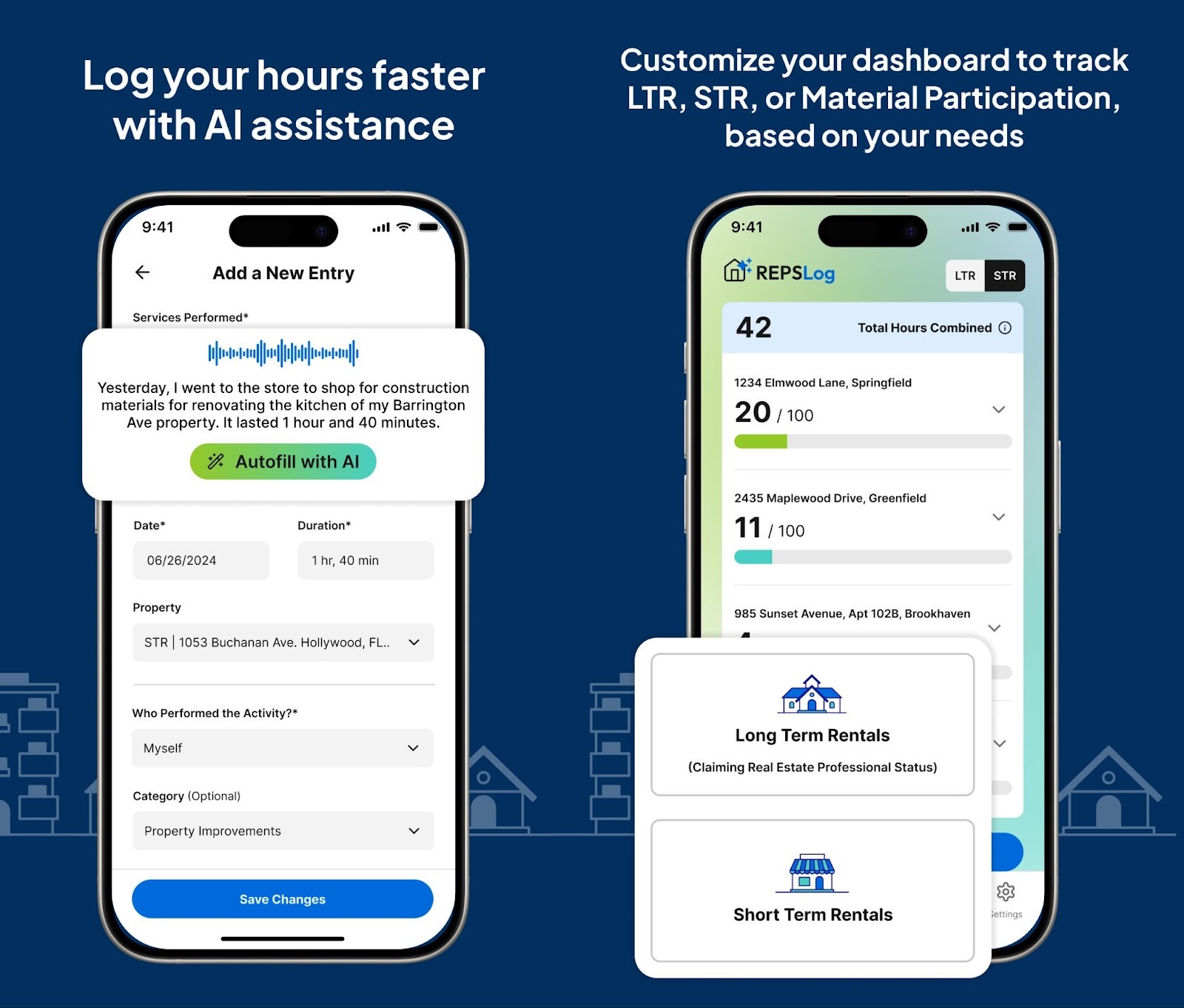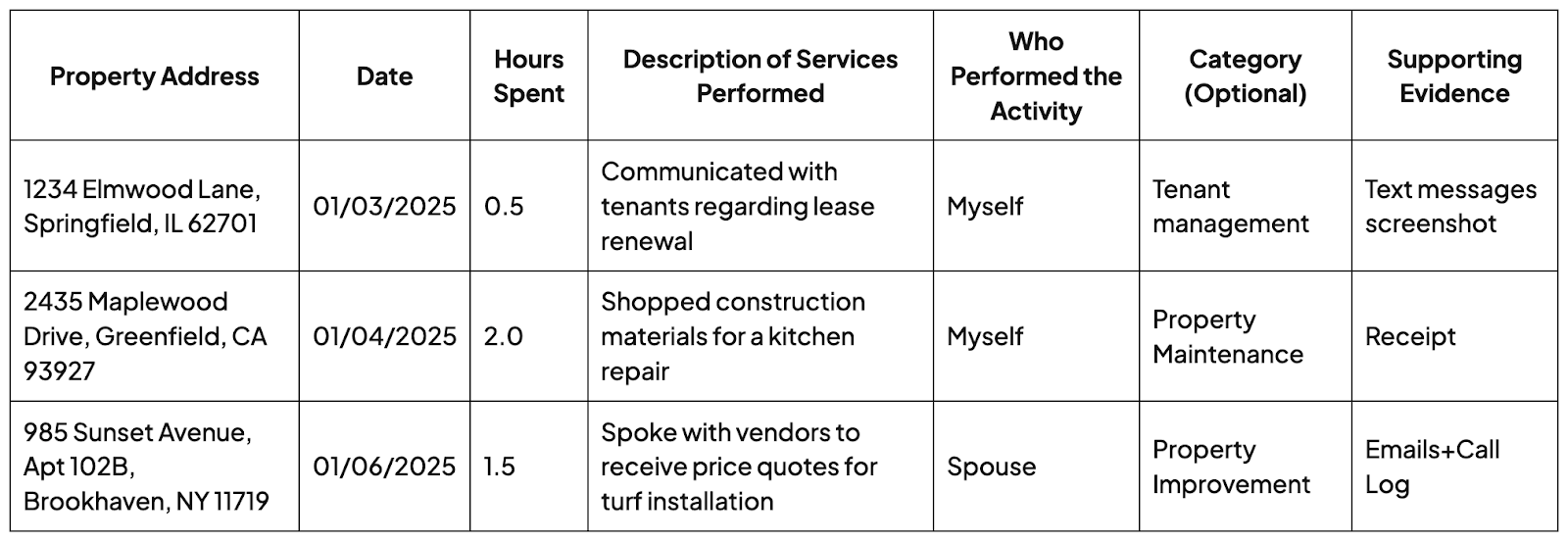If you are using real estate as a tax strategy, being able to prove your material participation is essential. This is especially true if you want to qualify for Real Estate Professional Status (REPS) or take advantage of the Short-Term Rental (STR) loophole. In this article, we’ll explain what each strategy is, who can qualify, and the differences between them. Then we’ll cover the best practices for documenting your hours and show how REPSLog can simplify the process and keep you audit-ready.
What Is REPS and What Is the STR Loophole?
Real Estate Professional Status (REPS)
By default, rental activities are considered passive, meaning losses can only offset passive income. Qualifying as a Real Estate Professional allows you to treat rental losses as non-passive, so they can offset wages or business income.
To qualify for REPS, you must:
- Spend more than 50% of your working hours in real property trades or businesses (management, development, brokerage, improvements, etc.), and
- Log at least 750 hours in those activities during the year.
Only one spouse must qualify if you file jointly.
Who usually qualifies?
- Investors who self-manage their rentals
- Real estate professionals such as brokers, agents, and property managers
- Spouses of high earners who devote their time to actively running a portfolio
The STR Loophole
The STR loophole is different. It applies specifically to short-term rentals (Airbnb, VRBO, and similar). If your average guest stay is 7 days or less (or 30 days or less if you provide substantial services such as cleaning or meals), you do not need REPS to treat your STR losses as non-passive. Instead, you must show material participation.
The most common ways to meet this are:
- Working 500 hours on the property in the year,
- Working 100 hours and more than anyone else (including co-hosts and cleaners), or
- Doing substantially all of the work yourself.
This allows STR owners to offset other income without having to meet REPS’s 750-hour and 50% thresholds.
Who benefits most?
- Active STR hosts who manage their properties themselves
- Full-time employees who still participate heavily in their rentals
- Investors with multiple STRs who oversee operations directly
Why Tracking Hours Matters for REPS and STR
Both REPS and STR strategies depend on proving your involvement. The IRS will not accept estimates. In an audit, they expect logs that show:
- The date and time spent
- A clear description of the activity
- The property involved
- Who performed the work
- Supporting documentation such as emails, receipts, booking records, or photos
Without proper logs, even legitimate hours may be denied.
How REPSLog Simplifies Your Tracking
REPSLog is built specifically for investors using REPS or the STR loophole. Here’s how it helps:
- Log faster with AI assistance: Just speak or type what you worked on—REPSLog fills in the rest.
- Track your progress: See exactly how close you are to hitting the 750, 500, or 100-hour thresholds.
- Manage multiple properties: Add unlimited LTR and STR properties, tag entries, and stay organized with filters.
- Add and monitor participants' time: Track hours for your spouse, cleaner, or others to confirm you're the primary participant.
- Maintain audit-ready records: Attach images, screenshots, or documents to any entry and export everything to CSV when needed.
Instead of wrestling with unwieldy spreadsheets, REPSLog gives you structure, defensibility, and scalability.

Sample REPS Log
Here is an example of what a strong log entry looks like:

It includes the date, duration, tasks, property, participant, and supporting evidence. That’s the level of detail the IRS expects.
Activities That Count (and Those That Don’t)
The IRS wants to see operational involvement. Examples of activities that usually qualify:
- Responding to tenant or guest messages
- Scheduling or supervising cleaning and repairs
- Adjusting pricing, calendars, or bookings
- Buying supplies or staging units
- Coordinating with contractors or vendors
- Overseeing renovations or inspections
- Handling leases, renewals, or insurance
Activities that typically do not qualify:
- Listening to podcasts or reading books about real estate
- Browsing Zillow without acting on it
- Attending educational events or seminars
- Investing passively in someone else’s deal
Simple rule to remember: If you personally carried out the task and it directly advanced your rental operations, it usually counts toward your hours.
Why Pair REPS or STR With Cost Segregation
Qualifying for REPS or materially participating in your STR is a huge win, but the status by itself doesn’t generate tax savings. You need real deductions to actually write off against your income, and that’s where a cost segregation study comes in.
A cost segregation breaks a property into shorter-lived components like appliances, flooring, and fixtures. Instead of depreciating everything over 27.5 years, you can move a large portion into year one and accelerate the deductions.
When paired with REPS or STR, your time log proves the status and makes those losses non-passive, while the cost segregation study provides the deductions. Together, they create the tax benefit investors are looking for by turning paper losses into real offsets against W-2 wages, business profits, or other active income.
Your Next Steps (Quick Action Plan)
- Work with your CPA to decide on a strategy - whether to pursue REPS or rely on the STR tax loophole.
- Start logging today. The sooner you begin, the more accurate and credible your records will be.
- Use REPSLog to make tracking simple, structured, and audit-ready.
- Do periodic check-ins to confirm you’re staying on pace with your hour requirements.
- Review with your CPA regularly to validate your log format, strategy, and audit preparedness.

- REPS and STR serve different investors: REPS is designed for those whose main work revolves around real estate, while the STR loophole gives active short-term rental hosts a way to unlock deductions even if they have another full-time job.
- Proof is everything: The IRS doesn’t accept rough estimates. Detailed, timely logs with dates, tasks, properties, participants, and backup evidence are essential to defending your hours.
- REPSLog makes it easier: REPSLog replaces messy spreadsheets by offering mobile logging, voice-to-text, participant tracking, file attachments, progress dashboards, and audit-ready exports.
- Start logging early: Recording your activity throughout the year strengthens accuracy, builds credibility, and prevents stressful reconstructions at tax time.
- Pair with cost segregation: Achieving REPS or STR status opens the door, but accelerated depreciation through a cost segregation study creates the actual deductions you need to offset income.






.png)













